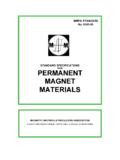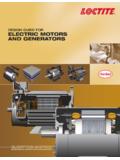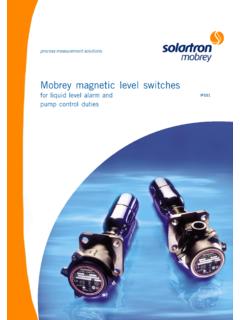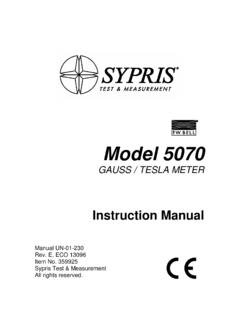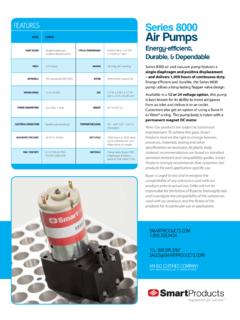Transcription of MAGNET GUIDELINES - Integrated Magnetics
1 Physics of permanent MAGNET materials . relationships, figures of merit and optimizing techniquesIll. MeasuringIV. and , standards and communicationsVII. BibliographyINTRODUCTIONThis guide is a supplement to our MMPA Standard No. 0100. It relates theinformation in the Standard to permanent MAGNET circuit problems. The guide isa bridge between unit property data and a permanent MAGNET component havinga specific size and geometry in order to establish a magnetic field in a givenmagnetic circuit environment.
2 The MMPA 0100 defines magnetic, thermal,physical and mechanical properties. The properties given are descriptive innature and not intended as a basis of acceptance or rejection. Magnetic measure-ments are difficult to make and less accurate than corresponding electrical mea-surements. A considerable amount of detailed information must be exchangedbetween producer and user if magnetic quantities are to be compared at twolocations. MMPA member companies feel that this publication will be helpful inallowing both user and producer to arrive at a realistic and meaningful specifica-tion Magnetic Materials Producers Association acknowledges the out-standing contribution of Rollin J.
3 Parker to this industry and designersand manufacturers of products usingpermanent MAGNET materials. MrParker the Technical Consultant to MMPA compiled and wrote thisdocument. We also wish to thank the standards and Engineering Com-mittee of MMPA which reviewed and edited this 1987 3 MJuly 1988 5 MAugust 1996 1 MDecember 1998 1 MCONTENTSThe guide is divided into the following sections:Glossary of terms and conversion tables-A very important starting point since the whole basis ofcommunication in the magnetic material industry involvesmeasurement of defined unit properties.
4 Physics of permanent MAGNET materials-An overview of the physics of permanent magnetism is felt tobe an important part of learning about permanent magnets.. relationships, figures of meritand optimizing techniques-Relationships are developed that allow materials to becompared. The figures of merit are a guide to the best choiceof unit properties for effectively using the energy conversionprocess in electromagnetic devices and systems.. ~ , .. and handling.. , standards and communications ..25 VII. Bibliography ..28 The sections on measuring, magnetizing and stabilizing contain the basicconsiderations that allow the user to choose the techniques most suitable fora specific permanent MAGNET component and operating OF TERMSAs Area of the air gap, or the cross sectional area of thean gap perpendicular to the flux path, is the averagecross sectional area of that portion of the air gap withinwhich the application interaction occurs.
5 Area is mea-sured in sq. cm. in a plane normal to the central flux lineof the air ,,, Area of the MAGNET , is the cross sectional area ofthe MAGNET perpendicular to the central flux line, mea-sured in sq. cm. at any point along its length. In design,A,,, is usually considered the area at the neutral sectionof the Magnetic induction, is the magnetic field induced bya field strength, H, at a given point. It is the vector sum,at each point within the substance, of the magnetic fieldstrength and resultant intrinsic induction.
6 Magnetic in-duction is the flux per unit area normal to the directionof the magnetic , Remanent induction, is any magnetic inductionthat remains in a magnetic material after removal of anapplied saturating magnetic field, H,. (Bd is the mag-netic induction at any point on the demagnetizationcurve: measured in gauss.)B,/H, Slope of the operating line, is the ratio of theremanent induction, Bd, to a demagnetizing force, H,.It is also referred to as the permeance coefficient, shearline, load line and unit ,H, Energy product, indicates the energy that a mag-netic material can supply to an external magnetic circuitwhen operating at any point on its demagnetizationcurve.
7 Measured in energy product, is the maximumproduct of (BtlHtt) which can be obtained on the demag-netization , (or J) Saturation intrinsic induction, is the maxi-mum intrinsic induction possible in a , Magnetic induction in the air gap, is the averagevalue of magnetic induction over the area of the air gap,A,; or it is the magnetic induction measured at a spe-cific point within the air gap; measured in (or J) Intrinsic induction, is the contribution of themagnetic material to the total magnetic induction, B. Itis the vector difference between the magnetic inductionin the material and the magnetic induction that wouldexist in a vacuum under the same field strength, H.
8 Thisrelation is expressed by the equation:Bi=B-Hwhere: Bi = intrinsic induction in gauss; B = magneticinduction in gauss; H = field strength in , Recoil induction, is the magnetic induction thatremains in a magnetic material after magnetizing andconditioning for final use; measured in , Magnetic induction, at the point of the maximumenerajr product (BH),,,,; measured in , Residual induction (or flux density), is the magneticinduction corresponding to zero magnetizing force in amagnetic material after saturation in a closed circuit;measured in Reluctance factor, accounts for the apparent mag-netic circuit reluctance.
9 This factor is required due tothe treatment of H, and H, as Leakage factor, accounts for flux leakage from themagnetic circuit. It is the ratio between the magneticflux at the MAGNET neutral section and the average fluxpresent in the air gap. F = (B, A,,)/(B, Ag).F Magnetomotive force, (magnetic potential differ-ence), is the line integral of the field strength, H, be-tween any two points, p1 and ;=; HdlPlF = magnetomotive force in gilbertsH = field strength in oerstedsdl = an element of length between the two points, Magnetic field strength, (magnetizing or demagne-tizing force), is the measure of the vector magneticquantity that determines the ability of an electric cur-rent, or a magnetic body, to induce a magnetic field at agiven point.
10 Measured in , Coercive force of a material, is equal to the demag-netizing force required to reduce residual induction, B,,to zero in a magnetic field after magnetizing to satura-tion; measured in ,i Intrinsic coercive force of a material indicates itsresistance to demagnetization. It is equal to the demag-netizing force which reduces the intrinsic induction, Bitin the material to zero after magnetizing to saturation;measured in , is that value of H corresponding to the remanentinduction, Bd; on the demagnetization curve, measuredin , is that value of H corresponding to the recoil induc-tion, B,; measured in , is the magnetic field strength at the point of themaximum energy product (BH)maX; measured recoil permeability, is the average slope of the re-coil hysteresis loop.
